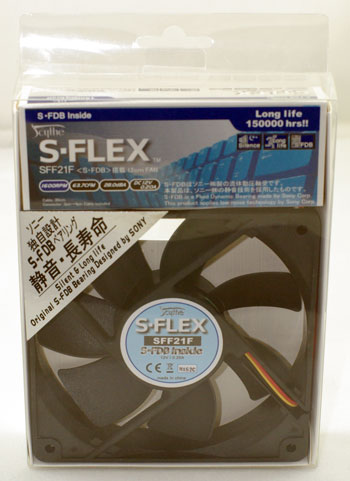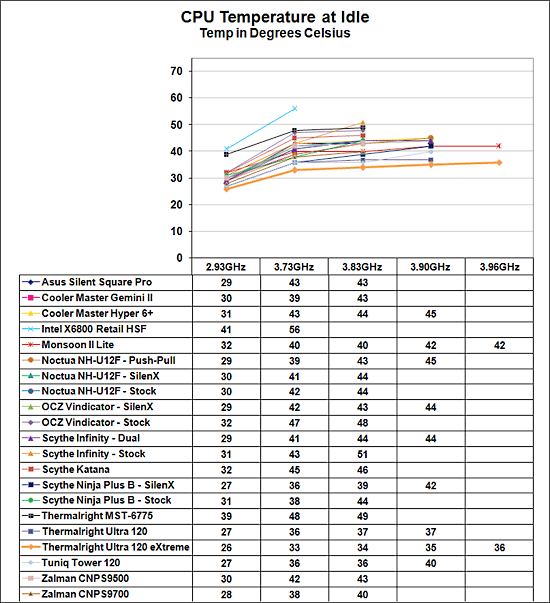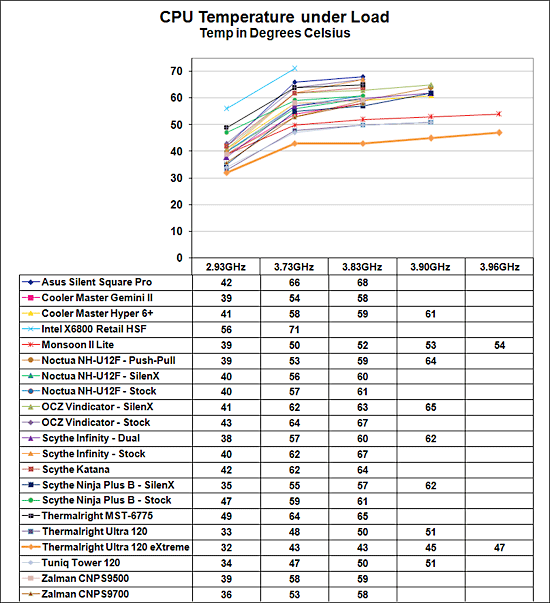UPDATE: Thermalright Ultra-120 eXtreme - Retail
by Wesley Fink on May 4, 2007 3:00 AM EST- Posted in
- Cases/Cooling/PSUs
Test Configuration
The test setup was exactly the same as used in the recent Thermalright Ultra-120 and Ultra-120 eXtreme preview. All the components of the test bench remained the same.

All cooling tests were run with the components mounted in a standard mid-tower case. The idle and stress temperature tests are run with the case closed and standing as it would in most home setups. We do not use auxiliary fans in the test cooling case, except for the Northbridge fan attached to the 680i for overclocking.
We tested with the same Scythe S-FLEX fan used in the Thermalright Ultra-120 review and the original Thermalright Ultra-120 eXtreme preview. This excellent fan moves a lot of air, but still keeps noise low with the Sony developed Fluid Dynamic Bearing on the fan motor. All testing was with a single fan, as in the earlier Thermalright reviews.
Scaling of Cooling Performance
Across stock speed and all overclocks the retail Thermalright Ultra-120 eXtreme produced temperatures either identical to the prototype review or within 1C of the previous test results. These are considered equivalent results and they verify that performance of the retail Thermalright Ultra-120 eXtreme is the same as we measured earlier.
The Ultra-120 and Tuniq Tower 120 set some very high performance standards for effective cooling in overclocking. By 3.73GHz, the highest stable overclock with the Intel retail HSF, the temperature at idle was 56C. This compared to 36C with both the Ultra-120 and the Tuniq Tower 120. The extra heatpipes of the Ultra-120 eXtreme lower this to an even better 33C. By 3.90 GHz, the previous best overclock, the idle for the Tuniq is 40C and the Ultra-120 is 37C. The Thermalright Ultra-120 eXtreme drops the idle 2C lower to 35C, and is still at 36C at the highest stable overclock of 3.94GHz. This is very close to the performance level of the Monsoon II which uses active TEC cooling and not air alone.
Cooling efficiency of the Ultra-120 eXtreme under load conditions was the best tested so far by a wide margin. Compared to the Ultra-120, Tuniq Tower 120 and other recently top CPU coolers it is clear that the extra heatpipes in the Ultra-120 eXtreme are very effective in extending cooling performance.
As you can see in the chart above the cooling efficiency of the Ultra-120 eXtreme under load is striking. Where the Tuniq Tower 120 and Ultra-120 mirror each other from 2.93GHz to 3.90GHz, the Thermalright Ultra-120 eXtreme creates a new performance curve at a lower temperature. The Tuniq and Ultra-120 are at 47/48 at 3.73GHz compared to the Intel retail at 71C. The Ultra-120 eXtreme shatters those cooling results by maintaining 43C.
The advantage increases even more as the overclock is raised. By 3.90 GHz, which is the highest overclock the Tuniq and Thermalright Ultra-120 could reach with stability, the Tuniq and Ultra-120 are both at 51C, which was the best performance among coolers tested so far. The Ultra-120 eXtreme, which is the same cooler as the Ultra-120 with just two additional heatpipes, bests both previous leaders by 6C with a 3.90GHz temperature of 45C.
Overclocking
The highest stable overclock we could achieve with the retail eXtreme was 3.93 GHz compared to the 3.94GHz achieved in the original review. Both results are higher than any achieved with any other cooler tested so far. We suspect this tiny difference is the result of either normal variation in test results, or even more likely the 2C higher ambient temperature in our test room compared to the room temperature in the initial review.
The test setup was exactly the same as used in the recent Thermalright Ultra-120 and Ultra-120 eXtreme preview. All the components of the test bench remained the same.
| Cooling Performance Test Configuration | |
| Processor | Intel Core 2 Duo X6800 (x2, 2.93GHz, 4MB Unified Cache) |
| RAM | 2x1GB Corsair Dominator PC2-8888 (DDR2-1111) |
| Hard Drive(s) | Hitachi 250GB SATA2 enabled (16MB Buffer) |
| Video Card | 1 x EVGA 7900GTX - All Standard Tests |
| Platform Drivers | NVIDIA 9.53 |
| NVIDIA nTune | 5.05.22.00 (1/16/2007) |
| Video Drivers | NVIDIA 93.71 |
| CPU Cooling | Thermalright Ultra-120 eXtreme Cooler Master Gemini II Noctua NF-U12F ASUS Silent Square Pro Scythe Ninja Plus Rev. B OCZ Vindicator Thermalright Ultra 120 Scythe Infinity Zalman CNS9700 Zalman CNS9500 CoolerMaster Hyper 6+ Vigor Monsoon II Lite Thermalright MST-9775 Scythe Katana Tuniq Tower 120 Intel Stock HSF for X6800 |
| Power Supply | OCZ PowerStream 520W |
| Motherboards | EVGA nForce 680i SLI (NVIDIA 680i) |
| Operating System | Windows XP Professional SP2 |
| BIOS | Award P24 (1/12/2007) |

All cooling tests were run with the components mounted in a standard mid-tower case. The idle and stress temperature tests are run with the case closed and standing as it would in most home setups. We do not use auxiliary fans in the test cooling case, except for the Northbridge fan attached to the 680i for overclocking.
We tested with the same Scythe S-FLEX fan used in the Thermalright Ultra-120 review and the original Thermalright Ultra-120 eXtreme preview. This excellent fan moves a lot of air, but still keeps noise low with the Sony developed Fluid Dynamic Bearing on the fan motor. All testing was with a single fan, as in the earlier Thermalright reviews.
Scaling of Cooling Performance
Across stock speed and all overclocks the retail Thermalright Ultra-120 eXtreme produced temperatures either identical to the prototype review or within 1C of the previous test results. These are considered equivalent results and they verify that performance of the retail Thermalright Ultra-120 eXtreme is the same as we measured earlier.
 |
| Click to enlarge |
The Ultra-120 and Tuniq Tower 120 set some very high performance standards for effective cooling in overclocking. By 3.73GHz, the highest stable overclock with the Intel retail HSF, the temperature at idle was 56C. This compared to 36C with both the Ultra-120 and the Tuniq Tower 120. The extra heatpipes of the Ultra-120 eXtreme lower this to an even better 33C. By 3.90 GHz, the previous best overclock, the idle for the Tuniq is 40C and the Ultra-120 is 37C. The Thermalright Ultra-120 eXtreme drops the idle 2C lower to 35C, and is still at 36C at the highest stable overclock of 3.94GHz. This is very close to the performance level of the Monsoon II which uses active TEC cooling and not air alone.
Cooling efficiency of the Ultra-120 eXtreme under load conditions was the best tested so far by a wide margin. Compared to the Ultra-120, Tuniq Tower 120 and other recently top CPU coolers it is clear that the extra heatpipes in the Ultra-120 eXtreme are very effective in extending cooling performance.
 |
| Click to enlarge |
As you can see in the chart above the cooling efficiency of the Ultra-120 eXtreme under load is striking. Where the Tuniq Tower 120 and Ultra-120 mirror each other from 2.93GHz to 3.90GHz, the Thermalright Ultra-120 eXtreme creates a new performance curve at a lower temperature. The Tuniq and Ultra-120 are at 47/48 at 3.73GHz compared to the Intel retail at 71C. The Ultra-120 eXtreme shatters those cooling results by maintaining 43C.
The advantage increases even more as the overclock is raised. By 3.90 GHz, which is the highest overclock the Tuniq and Thermalright Ultra-120 could reach with stability, the Tuniq and Ultra-120 are both at 51C, which was the best performance among coolers tested so far. The Ultra-120 eXtreme, which is the same cooler as the Ultra-120 with just two additional heatpipes, bests both previous leaders by 6C with a 3.90GHz temperature of 45C.
Overclocking
The highest stable overclock we could achieve with the retail eXtreme was 3.93 GHz compared to the 3.94GHz achieved in the original review. Both results are higher than any achieved with any other cooler tested so far. We suspect this tiny difference is the result of either normal variation in test results, or even more likely the 2C higher ambient temperature in our test room compared to the room temperature in the initial review.










44 Comments
View All Comments
JarredWalton - Saturday, May 5, 2007 - link
Wes looked at that in the earlier article, and depending on your PSU/case configuration it can certainly function fanless. Overclocking fanless isn't recommended, and I personally think you should still have some low RPM fans in every PC to be safe. If you undervolt a 120mm fan so it's only running at 400 RPM or so (or even the stock 800 RPM), it will still be inaudible and yet it will make a huge difference in cooling performance.fasdl - Saturday, May 5, 2007 - link
wow, those numbers are unreal! I can't believe this thing is really that good. Is this better at the point where it's better than water cooling?vailr - Friday, May 4, 2007 - link
Suggestion to Thermalright: replace the metal backplate; go to a non-conducting material. Such as found in the Zalman CS-2:http://sharkacomputers.com/zacsclsuforl.html">http://sharkacomputers.com/zacsclsuforl.html
Magnadoodle - Friday, May 4, 2007 - link
Thermalright products are know to perform better with more airflow while Scythe products usually perform better at low airflows. It would be interesting to test the passive cooling performance of the heatsinks, although that would imply alot of testing.noobzter - Friday, May 4, 2007 - link
Is it sticky? If it is, I wonder whether performance is affected if one were to use AS5.bigpow - Friday, May 4, 2007 - link
instead of using static charts for comparison tests, why don't you use a javascript-based chart?That'd allow readers to check/uncheck whats on the chart - just like the one on Yahoo stock chart
I haven't seen any other IT websites using this method, and it's only natural if Anandtech.com (my fav site) is the 1st one to have "live" chart
JarredWalton - Saturday, May 5, 2007 - link
I would *love* to have such a tool, mostly because the scaling graphs right now can be quite a pain in the hind quarters to generate. Unfortunately, such a tool takes development time, and while our web programmers are working on an overhaul of the graphing engine (and document engine in general) I'm not sure if we'll get an on-the-fly graph tool. I'll send the suggestion their way, though - it's at least worth considering, although server load might be a problem with such a design as well. We periodically get people that can't see some of the images for a variety of reasons, so any programmed graphics might be more trouble than they're worth. We'll see....Howard - Friday, May 4, 2007 - link
That way, you don't have to worry about the ambient temperature.Final Hamlet - Friday, May 4, 2007 - link
I really am interested in silencing my AM2 X2 3800+ - is it possible to run my CPU without any fans if I add a TR 120?Ender17 - Friday, May 4, 2007 - link
Great review, any idea when we can see a comparison with the IFX-14?